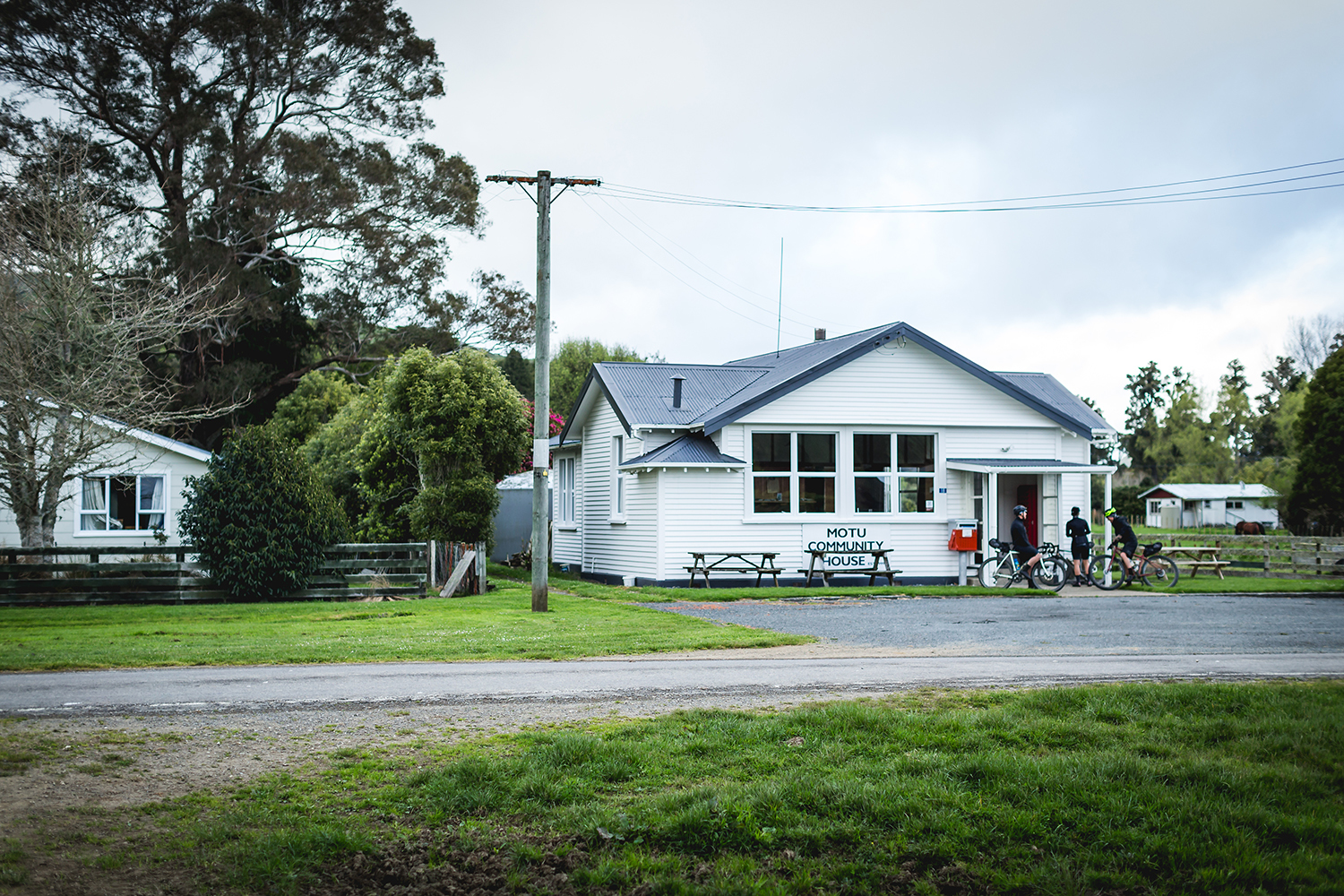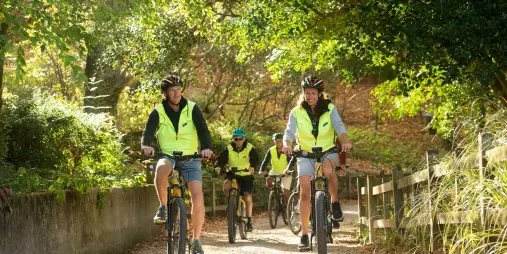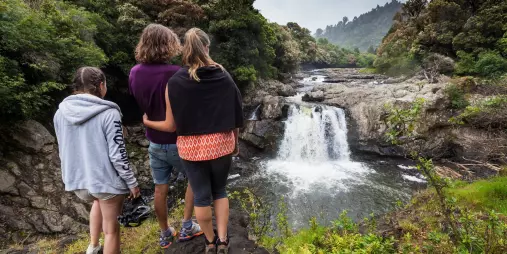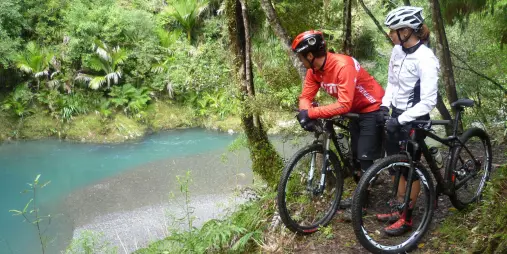A Diverse Ride Through Forests, Falls and Coastlines
The Motu Cycle Trails offer a unique chance to explore the wild beauty of New Zealand’s East Coast on two wheels. Beginning in the sunny, culture-rich city of Gisborne, the journey blends rugged coastal paths, native bush, and quiet rural roads. Cyclists can follow a well-marked trail network that includes the Dunes Trail, Pakihi Track, and Motu Road Trail, each delivering its own flavour of adventure. From gentle beachside rides to technical forest tracks, it’s a route designed for riders who love variety.
Along the way, there’s no shortage of iconic stops. Rere Falls, with its wide curtain of cascading water, is perfect for a refreshing break, while nearby Eastwoodhill Arboretum provides a peaceful detour through New Zealand’s largest collection of exotic trees. Whether you're a seasoned cyclist or a leisure rider, these trails are a brilliant way to connect with the land, the people, and the untamed beauty of the region.
Climb, Coast, and Cruise to Gisborne
Heading inland, the climb to Ngatapa Hill is a real highlight for cyclists seeking a rewarding ascent. The sweeping views from the top stretch over forests and farmland to the distant Pacific, offering a moment to pause and take it all in. The Motu Road Trail, steeped in pioneering history, cuts through remote country and bush-clad hills, giving riders a real taste of early Aotearoa landscapes.
As you return toward Gisborne, the ride eases out across the Poverty Bay Flats — a welcome cooldown after the climbs and descents. This stretch is perfect for reflecting on the journey and taking in the beauty of orchards, farmland, and ocean glimpses. Whether completed as a full circuit or in sections, the Motu Trails deliver a refreshing mix of challenge, solitude, and scenery.
Top Highlights of the Motu Cycle Trails
- Start your journey in sunny Gisborne
- Ride the coastal Dunes Trail from Ōpōtiki
- Tackle the forested Pakihi Track for a technical challenge
- Cruise the historic Motu Road through remote countryside
- Visit Rere Falls for a scenic rest stop
- Stroll through Eastwoodhill Arboretum, NZ’s national arboretum
- Climb Ngatapa Hill for epic views and photo ops
- Cycle across the Poverty Bay Flats on your return to Gisborne
- Enjoy local cafés, accommodation, and Māori culture along the route
- Ride short sections or complete the full trail experience
The Rere Falls Trail is a scenic and culturally rich route that extends from Gisborne to the Rere Falls and Rockslide. This approximately 100-kilometre trail offers a mix of paved and gravel roads, winding through picturesque countryside and past several notable landmarks. It's an ideal ride for those looking to experience the natural beauty and local attractions of the Gisborne region.
Terrain and Difficulty: The Rere Falls Trail is classified as a Grade 3 (Intermediate) track. The route combines sections of paved road, gravel paths, and undulating terrain. While it's suitable for intermediate riders, beginners with a reasonable level of fitness can also enjoy the ride, especially if they take their time and pace themselves.
Duration: 1-3 days
Grade: 3
Scenery and Highlights: Cyclists on the Rere Falls Trail are treated to a variety of landscapes, from rolling hills and farmland to lush forests and river valleys. Highlights include:
- Rere Falls: The trail's namesake, Rere Falls, is a stunning waterfall that cascades over a wide rock face. It's a perfect spot for a break, offering beautiful views and the soothing sound of falling water. The falls are easily accessible and provide a great photo opportunity.
- Rere Rockslide: Just a short ride from Rere Falls, the Rere Rockslide is a natural water slide formed by a smooth, sloping rock face. It's a popular spot for locals and visitors alike to enjoy a thrilling slide down the rock into the pool below. Remember to bring something to slide on, like a bodyboard or inflatable tube.
- Eastwoodhill Arboretum: Known as the National Arboretum of New Zealand, Eastwoodhill Arboretum houses the largest collection of Northern Hemisphere trees in the Southern Hemisphere. It's a botanical wonderland and a fantastic spot for a leisurely walk amidst diverse flora. The arboretum provides a peaceful and scenic detour on your ride.
- Wharekopae River: The trail follows the Wharekopae River for a significant portion of the route, offering lovely river views and several spots to stop and relax by the water.
- Farmland and Forest: The trail winds through diverse landscapes, including productive farmland and sections of native forest. This variety makes for an engaging ride with plenty of changing scenery.
- Local Vineyards: The Gisborne region is known for its vineyards, and the trail passes near several wineries. This provides an excellent opportunity for a vineyard visit and some wine tasting.
Preparation and Safety: Preparation is key for enjoying the Rere Falls Trail. Ensure your bike is in good condition, especially the tyres and brakes, as you'll encounter both paved and gravel sections. Carry enough water, snacks, and a first-aid kit. Weather can change, so check the forecast and dress in layers. Mobile coverage may be spotty in places, so inform someone of your plans before you head out.
Access Points: The trail begins in Gisborne, where you can find ample parking, bike rentals, and other amenities. From Gisborne, follow Wharekopae Road to the Rere Falls and Rockslide. The trail is well-marked, and there are signs along the way to guide you.
Nearby Amenities: Gisborne offers a full range of amenities, including accommodation, dining, and shopping options. The town is a great place to start and end your ride, with plenty to see and do before or after your journey on the Rere Falls Trail.
The Rere Falls Trail is a delightful mix of scenic beauty, cultural landmarks, and natural attractions. Whether you're an intermediate cyclist or a beginner up for a bit of a challenge, this trail offers a rewarding experience through one of New Zealand's most picturesque regions.
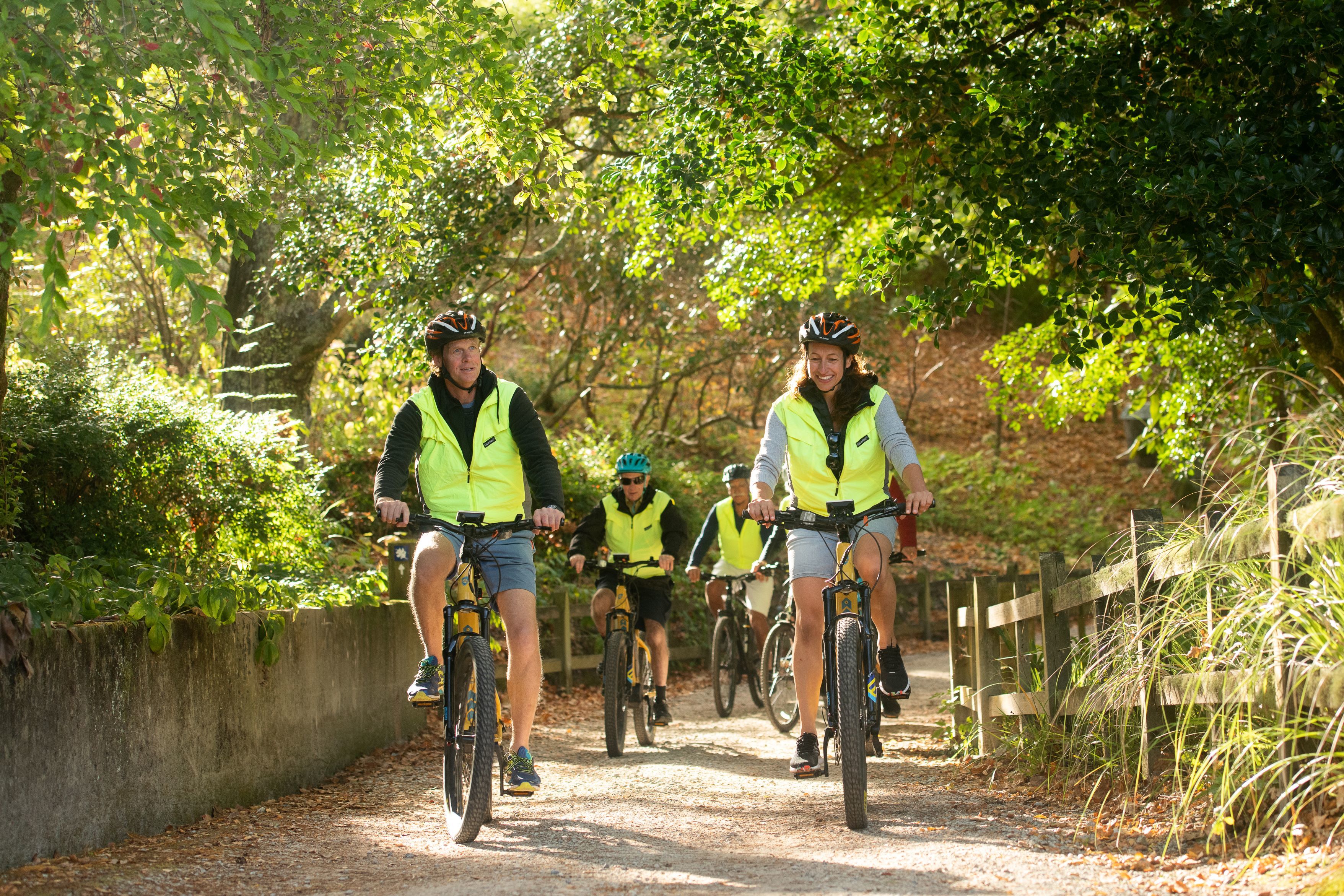
The Pakihi Track is one of the highlights of the Motu Cycle Trail, offering an exhilarating and scenic ride through some of New Zealand's most beautiful landscapes. Here's a more detailed look at what you can expect on this remarkable track.
Overview: The Pakihi Track is a 21-kilometre-long trail that descends through dense, lush native forest, providing an exciting and challenging ride for mountain biking enthusiasts. Originally built as a packhorse track in the early 1900s, it has been restored and maintained for recreational use, retaining much of its historical charm and rugged character.
Terrain and Difficulty: The track is mostly downhill, starting at an elevation of around 740 metres and descending to about 60 metres above sea level. The terrain is varied, with a mix of narrow single tracks, rocky sections, and wooden bridges. It's rated as a Grade 4 (Advanced) track, so it's best suited for experienced riders who are comfortable with technical riding and handling steep descents.
Duration: 3-6 hours
Grade: 4
Scenery and Highlights: Riders are treated to stunning views and a rich natural environment throughout the track. The dense forest is filled with towering trees, ferns, and a variety of native plants. The Pakihi Stream runs alongside much of the trail, providing the soothing sound of flowing water and opportunities to spot native wildlife. Numerous small waterfalls and cascades add to the track's picturesque quality.
Key Features:
- Historic Charm: The track's history as a packhorse route adds a unique element to the ride. You'll pass by remnants of old structures and original stonework that offer a glimpse into the past.
- Wooden Bridges: There are several wooden bridges crossing the Pakihi Stream, adding both to the scenic beauty and the technical challenge of the ride. These bridges vary in length and construction, providing a diverse riding experience.
- Scenic Rest Stops: There are numerous spots along the track where you can take a break, enjoy the scenery, and even have a picnic. These rest areas are perfect for soaking in the tranquillity of the forest and recharging before continuing your ride.
Preparation and Safety: Given its advanced rating, it's important to be well-prepared before tackling the Pakihi Track. Ensure your bike is in good condition, with robust tyres and reliable brakes. Carry sufficient water, snacks, and a first-aid kit. Weather conditions can change rapidly, so check the forecast and dress appropriately. Cellphone coverage is limited, so inform someone of your plans before setting out.
Access Points: The track can be accessed from the Motu Road end, where there's a car park and information board. Alternatively, you can arrange for a shuttle drop-off at the start of the Pakihi Track if you prefer to avoid the initial climb. The track finishes at the Pakihi Bridge, where you can continue your journey along the Motu Cycle Trail or arrange for transport back to your starting point.
The Pakihi Track is a thrilling and rewarding part of the Motu Cycle Trail, offering an unforgettable ride through pristine New Zealand wilderness. Whether you're an experienced mountain biker seeking a challenge or a nature lover wanting to immerse yourself in beautiful surroundings, the Pakihi Track is a must-ride section of this incredible trail.

The Dunes Trail is a beautiful and accessible section of the Motu Cycle Trail, offering stunning coastal views and a gentle ride that's perfect for all levels of cyclists. Stretching for approximately 10 kilometres, this trail runs from Opotiki to the picturesque Tirohanga Beach, showcasing some of the best coastal scenery New Zealand has to offer.
Terrain and Difficulty: The Dunes Trail is classified as a Grade 2 (Easy) track, making it suitable for families, beginners, and casual riders. The trail features a smooth, wide path that is well-maintained, with gentle undulations that add variety without being too challenging. The surface is mostly compacted gravel and boardwalks, ensuring a comfortable ride.
Duration: 2-3 hours
Grade: 2
Scenery and Highlights: Riders on the Dunes Trail are treated to magnificent coastal views, with the sparkling waters of the Pacific Ocean on one side and rolling sand dunes on the other. The trail winds through a diverse landscape, including native bush, coastal vegetation, and sandy beaches. Here are some of the highlights:
- Coastal Vistas: The trail offers uninterrupted views of the ocean, providing plenty of opportunities for stunning photographs. The sight of waves crashing against the shore and the sound of seabirds add to the trail's serene atmosphere.
- Wildlife: Keep an eye out for local wildlife, including native birds such as dotterels and oystercatchers. The diverse habitats along the trail support a variety of species, making it a great spot for birdwatching.
- Rest Areas: There are several designated rest areas along the trail, complete with benches and picnic tables. These spots are perfect for taking a break, enjoying a snack, and soaking in the coastal scenery.
- Beach Access: The trail provides access to several beautiful beaches, where you can stop for a swim or a stroll along the shore. Tirohanga Beach is particularly popular, known for its golden sands and clear waters.
Preparation and Safety: The Dunes Trail is well-suited for a leisurely ride, but it's always good to be prepared. Make sure to bring water, sunscreen, and a hat, as the coastal sun can be strong. The trail is generally safe and family-friendly, but it's advisable to keep an eye on younger riders, especially near the beach access points.
Access Points: The trail starts at the Pakowhai ki Otutaopuku Bridge in Opotiki, where there's parking available and an information board with trail details. The trail ends at Tirohanga Beach, but you can easily turn back at any point to return to Opotiki. For those looking to extend their ride, the Dunes Trail connects seamlessly with the Motu Road Trail and other sections of the Motu Cycle Trail.
Nearby Amenities: Opotiki is a great base for exploring the Dunes Trail, offering a range of amenities including cafes, bike rentals, and accommodation. After your ride, you can explore the charming town, visit local shops, or relax at a café.
The Dunes Trail is a fantastic introduction to the Motu Cycle Trail, offering a blend of easy riding and breathtaking scenery. Whether you're a beginner cyclist or just looking for a relaxing ride with stunning coastal views, the Dunes Trail is a must-ride section of this iconic New Zealand trail.

The Motu Road Trail is a captivating and historic section of the Motu Cycle Trail, stretching from the small settlement of Matawai to the village of Motu. Covering around 67 kilometres, this trail offers a mix of rugged terrain, historical significance, and breathtaking scenery, making it a favourite for more experienced cyclists seeking adventure.
Terrain and Difficulty: The Motu Road Trail is classified as a Grade 3 (Intermediate) track. It features a mix of gravel roads, rolling hills, and some steeper sections. The trail winds through remote areas, requiring riders to be reasonably fit and well-prepared. The road's gravel surface can be challenging in places, adding to the adventure.
Duration: 1-2 days
Grade: 3
Scenery and Highlights: Cyclists on the Motu Road Trail are treated to a variety of landscapes, from dense native forests to open farmland and stunning river valleys. Highlights include:
- Historic Route: The Motu Road is one of New Zealand’s oldest roads, originally built in the early 1900s. Cycling this trail provides a sense of history and a connection to the past, with old stone bridges and remnants of early road construction.
- Native Forest: The trail passes through extensive areas of native bush, where you can enjoy the sights and sounds of New Zealand’s flora and fauna. The forest sections are particularly beautiful, with towering trees and lush undergrowth.
- Scenic Views: As you ascend and descend the rolling hills, you’ll be rewarded with panoramic views of the surrounding countryside, including vistas of the Motu River and the Raukumara Range.
- Remote Beauty: The trail’s remote location means you’ll experience a sense of solitude and tranquillity, far from the hustle and bustle of city life. It’s an excellent opportunity to disconnect and immerse yourself in nature.
- Picnic Spots: There are several spots along the trail where you can stop for a picnic or a rest. These areas offer stunning views and a chance to refuel before continuing your journey.
Preparation and Safety: Given its intermediate rating, the Motu Road Trail requires some preparation. Ensure your bike is in good condition, particularly with sturdy tyres suitable for gravel roads. Bring plenty of water, snacks, and a first-aid kit. Weather can be unpredictable, so check forecasts and dress appropriately. Mobile coverage is limited, so let someone know your plans before you set off.
Access Points: The trail starts in Matawai, where you can find parking and basic amenities. From Matawai, the trail heads towards Motu, passing through beautiful and varied landscapes. At the end of the trail in Motu, there are additional amenities, including accommodation options for those wishing to stay overnight.
Nearby Amenities: Both Matawai and Motu are small settlements but offer basic services. Matawai has a café, general store, and accommodation options. In Motu, you’ll find additional accommodation and opportunities to explore the local area.
The Motu Road Trail is a remarkable journey through some of New Zealand’s most scenic and historic landscapes. Whether you’re an experienced cyclist looking for a challenge or a history buff interested in early New Zealand roads, the Motu Road Trail offers a unique and rewarding experience.

The Motu Trails Loop is an extraordinary cycling adventure that combines several distinct trails into one cohesive experience. Located in the Eastern Bay of Plenty region, this loop encompasses the Dunes Trail, the Motu Road Trail, the Pakihi Track, and connections back to Opotiki. The complete loop covers approximately 91 kilometres, offering a mix of coastal beauty, rugged backcountry, and lush forest trails.
Terrain and Difficulty: The Motu Trails Loop is classified as a Grade 3 (Intermediate) trail. It features a variety of terrains, including smooth coastal paths, gravel roads, and challenging forest tracks. While it is accessible for most riders with a reasonable level of fitness, some sections, like the Pakihi Track, require more technical riding skills.
Duration: 1-2 days
Grade: 2-4
Scenery and Highlights: The Motu Trails Loop offers cyclists a diverse range of landscapes and numerous highlights:
- Dunes Trail: Starting from Opotiki, the Dunes Trail offers a gentle introduction with its smooth path along the coastline. Cyclists can enjoy stunning views of the Pacific Ocean, golden sand dunes, and native coastal vegetation.
- Motu Road Trail: This section provides a journey through history, following one of New Zealand’s oldest roads. The gravel path winds through rolling hills, native bush, and farmland, offering panoramic views and a sense of adventure.
- Pakihi Track: Known for its exhilarating descent through dense forest, the Pakihi Track is a highlight for experienced mountain bikers. The trail features narrow single tracks, wooden bridges, and the serene Pakihi Stream, making for a thrilling ride.
- Eastwoodhill Arboretum: Along the loop, a detour to the Eastwoodhill Arboretum, the National Arboretum of New Zealand, is highly recommended. It houses the largest collection of Northern Hemisphere trees south of the equator, offering a peaceful and scenic break.
- Wharekopae River and Rere Falls: The loop provides opportunities to explore natural attractions like the Wharekopae River and Rere Falls. The falls are a great spot for a refreshing break and a unique natural rockslide.
Preparation and Safety: Proper preparation is essential for tackling the Motu Trails Loop. Ensure your bike is in excellent condition, particularly the tyres and brakes, as you'll encounter a variety of surfaces. Pack plenty of water, snacks, and a first-aid kit. Weather conditions can change quickly, so check the forecast and dress in layers. Mobile coverage is limited in some areas, so inform someone of your plans and carry a map or GPS device.
Access Points: The loop typically starts and ends in Opotiki, where you can find parking, bike rentals, and other amenities. The town is well-equipped to serve as a base for your adventure, with accommodation options and places to eat. The trails are well-marked, and there are several entry and exit points along the way, allowing for flexible itineraries.
Nearby Amenities: Opotiki offers a range of services, including bike shops, cafes, and accommodation. Along the route, small settlements like Matawai and Motu provide additional opportunities for rest and resupply. The region’s friendly locals and well-maintained facilities ensure a comfortable and enjoyable experience.
The Motu Trails Loop is a spectacular journey through some of New Zealand’s most stunning landscapes. With its mix of coastal paths, historical trails, and challenging forest tracks, it offers something for every cyclist. Whether you're seeking adventure, scenic beauty, or a bit of both, the Motu Trails Loop is an unforgettable ride.

The Raukumara Traverse is a challenging and remote trail that takes cyclists and hikers through the rugged and pristine landscapes of the Raukumara Range in the Eastern Bay of Plenty region. This traverse is not for the faint-hearted, as it involves navigating steep terrain, dense forest, and often unpredictable weather. The trail offers an unforgettable adventure for those seeking to explore one of New Zealand’s lesser-known wilderness areas.
Terrain and Difficulty: The Raukumara Traverse is classified as a Grade 5 (Expert) trail. The 175 km route includes a mix of rough tracks, steep climbs, and technical descents. The terrain is varied, ranging from rocky paths to muddy sections, and often requires carrying your bike or gear over difficult sections. This trail is best suited for experienced and well-prepared adventurers with a high level of fitness and technical skill.
Duration: 4 days
Grade: 3
Scenery and Highlights: The Raukumara Traverse offers a true wilderness experience, with stunning natural features and diverse landscapes. Highlights include:
- Dense Native Forest: The trail passes through vast tracts of native forest, home to a rich variety of flora and fauna. The forest is dense and lush, providing a sense of seclusion and tranquillity.
- Panoramic Views: From the high points along the trail, you’ll be rewarded with breathtaking views of the surrounding mountains, valleys, and coastlines. The vistas offer a sense of the sheer scale and beauty of the Raukumara Range.
- Remote Wilderness: The Raukumara Traverse takes you into one of New Zealand’s most remote areas, far from the comforts of civilization. The solitude and untouched nature of the landscape are truly awe-inspiring.
- River Crossings: The trail includes several river crossings, which add to the adventure and challenge of the traverse. These crossings require careful navigation and can be particularly tricky after heavy rain.
- Wildlife: The Raukumara Range is home to a variety of native wildlife, including birds such as kererū, tūī, and the rare North Island brown kiwi. Wildlife enthusiasts will appreciate the opportunity to spot these creatures in their natural habitat.
Preparation and Safety: The Raukumara Traverse requires thorough preparation and careful planning. Ensure your gear is in top condition, including a sturdy, well-maintained bike if cycling, and appropriate hiking equipment. Carry ample supplies of food, water, and emergency gear, as there are no facilities along the route. Navigation skills are crucial, and carrying a detailed map, compass, and GPS device is recommended. Inform someone of your plans and expected return time, as mobile coverage is limited.
Access Points: The traverse typically starts from the Motu Road end and heads deep into the Raukumara Range. The route is remote, and access points are limited, so it’s important to plan your entry and exit carefully. Some adventurers arrange transport to drop them off and pick them up at designated points.
Nearby Amenities: Given its remote nature, amenities near the Raukumara Traverse are sparse. The nearest towns with services are Opotiki and Gisborne, where you can find accommodation, food, and supplies. These towns serve as good bases for final preparations and recovery after your traverse.
The Raukumara Traverse offers a demanding but immensely rewarding adventure for those looking to explore New Zealand’s wild side. With its challenging terrain, stunning scenery, and remote wilderness, it provides a unique and unforgettable experience.
The Coaster route is a scenic and diverse journey that takes cyclists from Matawai to Opotiki, and then around the stunning East Cape to Gisborne. This epic ride covers a variety of terrains and landscapes, offering a mix of coastal views, rugged countryside, and cultural experiences. The total distance is approximately 330 kilometres, making it a multi-day adventure that showcases the best of New Zealand's East Coast.
Terrain and Difficulty: The Coaster 410 km route is primarily on-road, with a combination of paved highways and quieter rural roads. It is suitable for riders with a moderate to high level of fitness, as there are several challenging climbs and long distances between towns. The route is classified as a Grade 3 (Intermediate) to Grade 4 (Advanced) ride, depending on specific sections and weather conditions.
Duration: 7 days
Grade: 3-4
Scenery and Highlights: Cyclists on the Coaster route are treated to a diverse array of landscapes and cultural highlights. Key points of interest include:
- Motu Road Trail: Starting in Matawai, cyclists can take the historic Motu Road Trail, a gravel route that winds through native bush and farmland, providing a sense of adventure and history.
- Motu River Trips: Before reaching Opotiki, consider a detour to explore the Motu River. Known for its pristine waters and stunning gorges, the river offers opportunities for kayaking, rafting, and scenic boat trips, adding an extra dimension to your journey.
- Opotiki: This charming town marks the end of the Motu Road Trail and the beginning of the coastal journey. Opotiki offers amenities, historical sites, and access to the beautiful Dunes Trail.
- East Cape Coastal Ride: The stretch from Opotiki to Gisborne follows the dramatic coastline of the East Cape. Cyclists will enjoy stunning ocean views, secluded beaches, and the unique opportunity to visit the easternmost point of New Zealand at East Cape Lighthouse.
- Maunga Hikurangi: A significant cultural and historical site, Maunga Hikurangi is the sacred mountain of the Ngati Porou people. A side trip to climb this mountain provides incredible views and a deep connection to Maori culture and mythology.
- Marae Visits: The route passes through several Maori communities, offering the chance to experience local culture and hospitality. Visiting a marae (meeting ground) can provide insights into Maori traditions and heritage.
- Te Araroa: This small coastal town is a great stopover point, known for its proximity to the East Cape Lighthouse and the historic Pohutukawa tree, reputed to be the largest in the world.
- Tolaga Bay Wharf: As you approach Gisborne, a detour to the Tolaga Bay Wharf, the longest wharf in the Southern Hemisphere, is a must. It’s a beautiful spot for a walk and offers fantastic photo opportunities.
- Cooks Cove: Near Tolaga Bay, Cooks Cove is another must-visit site. This historic location is where Captain James Cook made his first landing in New Zealand in 1769. The cove is accessible via a scenic walking track that offers stunning views and a glimpse into the country's early exploration history.
Preparation and Safety: Cycling the Coaster route requires careful planning and preparation. Ensure your bike is in excellent condition, especially the tyres and brakes, as you’ll encounter varied terrain. Carry sufficient water, food, and emergency supplies, as some sections are remote with limited services. Check the weather forecast, dress appropriately, and use sun protection. Navigation aids like maps, GPS, and a mobile phone are essential, though mobile coverage can be sporadic in remote areas.
Access Points: The journey typically starts in Matawai, a small settlement that can be accessed from Gisborne. From Matawai, follow the Motu Road Trail to Opotiki, then continue along State Highway 35 around the East Cape to Gisborne. The route is well-marked, and there are various entry and exit points along the way.
Nearby Amenities: Opotiki and Gisborne are the primary towns with comprehensive services, including accommodation, food, bike shops, and other amenities. Along the route, smaller towns like Te Araroa, Ruatoria, and Tolaga Bay offer basic facilities and accommodation options, making it feasible to plan overnight stops.
The Coaster route from Matawai to Opotiki and around the East Cape to Gisborne is a magnificent journey through some of New Zealand’s most spectacular coastal and rural landscapes. With opportunities to explore the Motu River, climb Maunga Hikurangi, and visit Cooks Cove, it’s a ride that combines natural beauty, cultural richness, and a sense of adventure, making it a must-do for cycling enthusiasts.
